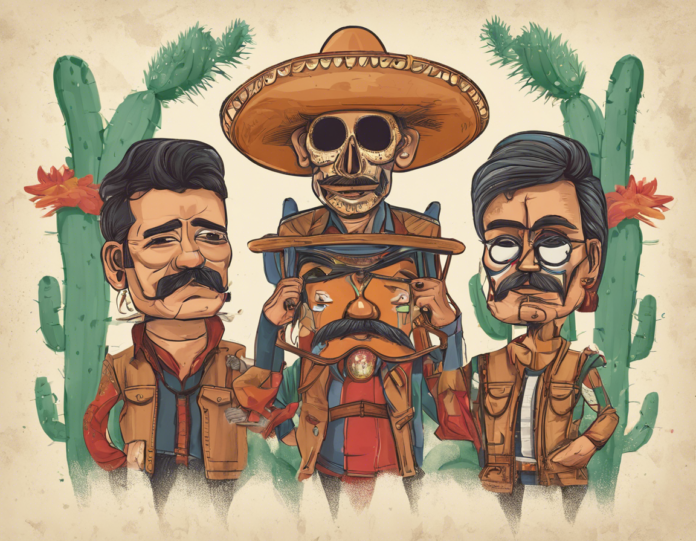With its vibrant and diverse culinary scene, Mexico offers a rich tapestry of flavors that have captivated taste buds around the world. From the fiery heat of chilies to the earthy aromas of cacao, Mexican cuisine is a celebration of bold spices, fresh ingredients, and centuries-old traditions. In this article, we will delve into the exquisite flavors of Los Mexicanos – the Mexican people – and explore the key ingredients, dishes, and culinary techniques that make Mexican food so distinctive and irresistible.
The Heart of Mexican Cuisine: Key Ingredients
1. Corn (Maíz):
Corn holds a revered place in Mexican cuisine, with tortillas being a staple in most Mexican meals. Maíz is not only the base for tortillas but also for other traditional foods such as tamales, tlacoyos, and sopes.
2. Chilies (Chiles):
Chilies are at the core of Mexican cooking, providing heat, depth, and flavor to dishes. From the mild poblano to the fiery habanero, there is a chili for every taste preference. Chiles are used fresh, dried, and smoked in a myriad of Mexican recipes.
3. Avocado (Aguacate):
Creamy and luscious, avocado is a signature ingredient in Mexican cuisine. It’s not just for making guacamole; avocado is used in salads, salsas, and as a topping for tortas and tacos.
4. Chocolate (Chocolate):
Mexico is the birthplace of chocolate, and cacao has deep roots in Mexican culinary history. Mexican chocolate is often flavored with cinnamon and almonds and is used in both savory and sweet dishes.
5. Tomatoes (Tomates):
Tomatoes are a foundational ingredient in Mexican salsas, moles, and stews. Mexican tomatoes are known for their intense flavor and vibrant color, adding brightness to dishes.
Regional Flavors: Culinary Diversity in Mexico
1. Oaxaca
Known as the culinary capital of Mexico, Oaxaca boasts a rich gastronomic heritage. Oaxacan cuisine is renowned for dishes such as mole negro (a dark, complex sauce), tlayudas (crispy tortillas topped with beans, cheese, and meats), and chapulines (toasted grasshoppers).
2. Yucatán
The Yucatán Peninsula offers a unique blend of Mayan, Spanish, and Caribbean influences. Yucatecan cuisine features achiote-marinated pork, sikil p’ak (pumpkin seed dip), and cochinita pibil (slow-roasted pork).
3. Puebla
Puebla is the birthplace of mole poblano, a rich sauce made with chocolate, chilies, nuts, and spices. Other iconic dishes from Puebla include chiles en nogada (stuffed chilies in walnut sauce) and cemita poblana (a sandwich with breaded meat and avocado).
Culinary Techniques: The Art of Mexican Cooking
1. Masa Preparation:
The process of nixtamalization, where dried corn is treated with lime to create nixtamal, is a fundamental technique in Mexican cooking. Nixtamal is ground into masa (dough) to make tortillas, tamales, and other corn-based dishes.
2. Mole Making:
Mole is a labor-intensive sauce that requires toasting and grinding chilies, spices, nuts, and other ingredients. Each region in Mexico has its own variation of mole, making it a versatile and complex element of Mexican cuisine.
3. Comal Cooking:
A comal is a flat griddle used to cook tortillas, quesadillas, and toast chilies and spices. Comal cooking imparts a smoky flavor and char to ingredients, adding depth to dishes.
4. Ceviche Preparation:
Ceviche is a popular dish along Mexico’s coastlines, where fresh seafood is marinated in lime juice, chilies, and herbs. The acidic marinade “cooks” the fish or shrimp, resulting in a refreshing and zesty dish.
FAQs: Exploring Mexican Cuisine
1. What are the essential spices in Mexican cooking?
Cumin, cinnamon, oregano, and paprika are key spices used in Mexican cuisine to add depth and complexity to dishes.
2. Are all Mexican dishes spicy?
While chilies are prevalent in Mexican cuisine, not all dishes are spicy. Mexican food offers a wide range of flavors beyond just heat.
3. What is the difference between tacos and burritos?
Tacos are typically smaller, with a soft tortilla folded around fillings, while burritos are larger and tightly rolled with fillings inside a tortilla.
4. Is chocolate a common ingredient in savory Mexican dishes?
Yes, chocolate is used in savory Mexican dishes, particularly in mole sauces where it adds richness and depth of flavor.
5. What is the national dish of Mexico?
There isn’t one single national dish, but mole poblano is often considered Mexico’s national dish due to its popularity and cultural significance.
6. Is Mexican food gluten-free?
Many traditional Mexican dishes are naturally gluten-free, especially those based on corn masa such as tortillas and tamales. However, caution should be taken with sauces and processed foods containing gluten.
From the bustling markets of Mexico City to the coastal villages of Baja California, Mexican cuisine offers a culinary journey like no other. With its bold flavors, diverse ingredients, and rich cultural heritage, Los Mexicanos continue to inspire and delight food lovers worldwide. Dive into the world of Mexican gastronomy and savor the magic of its vibrant flavors and time-honored traditions.

